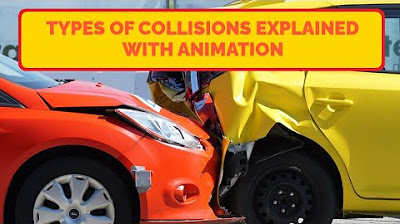Understanding Car Crashes: It's Basic Physics
Summary
TLDRThis video explores the physics behind car crashes, explaining concepts like inertia, momentum, and energy through demonstrations and real-world examples. It highlights the importance of vehicle design, seatbelts, and airbags in protecting occupants during accidents, emphasizing the unarguable laws of physics that govern these high-speed events.
Takeaways
- 🏎️ The Insurance Institute for Highway Safety's Vehicle Research Center is a place where researchers assess the crash performance of vehicles and evaluate new technologies to prevent injuries.
- 🧠 Griff Jones, a high school physics teacher, uses the center to illustrate the physical laws that govern the outcome of car crashes, emphasizing the importance of understanding basic physics in vehicle safety.
- 🛑 Inertia, the property of matter that resists changes in motion, plays a crucial role in car crashes. It's why a crash test dummy might continue moving at the original speed until acted upon by an external force, like the steering wheel or windshield.
- 💺 Seatbelts are essential because they help slow down the occupants of a vehicle with the vehicle itself during a crash, reducing the impact forces experienced by the body.
- 🚗 Newton's laws of motion, particularly the second law (F=ma), explain the relationship between crash forces and inertia, highlighting how force, mass, and acceleration interact in a collision.
- 🥚 Impulse, the product of force and the time during which the force acts, is a key concept in understanding how objects change momentum. Longer durations of impact can reduce the force needed to stop an object, as demonstrated by the egg experiment.
- 🚘 Cars with crumple zones or front ends that absorb crash forces more effectively can reduce the deceleration forces experienced by the occupants, potentially preventing more severe injuries.
- 📉 The concept of conservation of momentum, where the total quantity of motion remains constant in a collision, helps explain why occupants of lighter vehicles experience higher forces in a collision with a heavier vehicle.
- 🔋 Kinetic energy, the energy of motion, is a critical factor in car crashes. The formula KE = 1/2 mv^2 shows that kinetic energy is proportional to the square of the speed, making speed a significant determinant in the severity of a crash.
- 🛡️ Crashworthiness, a term used to describe the protection a car offers its occupants during a crash, involves many aspects of vehicle design, including the structure and restraint systems.
- 🔄 Extending the time of impact, as in the use of airbags and crumple zones, is a fundamental strategy in vehicle safety, reducing the forces experienced by the occupants and potentially preventing injury.
Q & A
What is the main theme of the video script?
-The main theme of the video script is the physics behind vehicle crashes, explaining how the laws of physics, particularly Newton's laws of motion, apply to car crashes and how they influence vehicle safety design and technology.
Who is Griff Jones and what is his role in the video?
-Griff Jones is a high school physics teacher who hosts the video. He guides the viewers through the concepts of physics that are relevant to car crashes, using the Insurance Institute for Highway Safety's Vehicle Research Center as a backdrop for his explanations.
What is the significance of the Insurance Institute for Highway Safety's Vehicle Research Center in the video?
-The Vehicle Research Center is significant as it is where research engineers assess the crash performance of vehicles and evaluate new technologies to prevent injuries. It serves as a practical laboratory for illustrating the physical laws that govern the outcomes of car crashes.
What is inertia and why is it important in the context of car crashes?
-Inertia is the property of matter that causes it to resist any change in its state of motion. It is important in car crashes because it explains why passengers continue moving at the original speed until acted upon by an external force, such as the impact with the steering wheel or windshield during a crash.
How does the concept of momentum relate to car crashes?
-Momentum, which is the product of an object's mass and velocity, is a measure of the quantity of motion. In car crashes, the change in momentum (impulse) due to a collision or impact is what can cause injury to the occupants. Extending the time over which this change occurs can reduce the force experienced by the occupants, thus improving safety.
What is the role of seatbelts in car crashes as explained in the script?
-Seatbelts are crucial in car crashes because they tie the occupants to the vehicle, allowing them to slow down with the occupant compartment as the vehicle's front end crumples and absorbs crash forces. This helps to counteract the effects of inertia and reduce the risk of injury.
What is the significance of Newton's second law of motion in the context of car crash safety?
-Newton's second law, often expressed as F=ma, explains the relationship between force, mass, and acceleration. In the context of car crash safety, it helps to understand the force needed to change the motion of a vehicle and its occupants, which is crucial for designing effective safety features like crumple zones and airbags.
What does the script reveal about the difference between a single vehicle crash and a collision between two vehicles?
-The script reveals that in a single vehicle crash, the vehicle's crumple zone and the distribution of forces over time play a significant role in the occupant's safety. In a collision between two vehicles, the conservation of momentum and the mass of each vehicle affect the acceleration experienced by the occupants, with those in lighter vehicles potentially experiencing higher forces.
How does the concept of kinetic energy relate to the outcome of a car collision?
-Kinetic energy, which depends on an object's mass and the square of its velocity, is a measure of the energy an object possesses due to its motion. The higher the kinetic energy, the more energy is available to do damage in a collision. Therefore, managing kinetic energy through vehicle design and safety features is crucial for occupant protection.
What is 'crashworthiness' and why is it important in vehicle design?
-Crashworthiness is a term used to describe the protection a car offers its occupants during a crash. It is important in vehicle design because it encompasses various aspects of the vehicle's structure and restraint systems, all of which contribute to the safety of the occupants in the event of a crash.
What is the role of crumple zones in vehicle safety?
-Crumple zones are designed to absorb and distribute the energy of a collision, thereby reducing the force transmitted to the occupant compartment. They are crucial for extending the time over which deceleration occurs, reducing the g-forces experienced by the occupants and improving their chances of survival in a crash.
How do airbags contribute to the safety of vehicle occupants during a crash?
-Airbags contribute to safety by providing a cushion between the occupant and the vehicle's interior during a crash. They rapidly inflate to extend the time over which the occupant's momentum is reduced, thus reducing the forces experienced by the occupant and mitigating the risk of injury.
Outlines

このセクションは有料ユーザー限定です。 アクセスするには、アップグレードをお願いします。
今すぐアップグレードMindmap

このセクションは有料ユーザー限定です。 アクセスするには、アップグレードをお願いします。
今すぐアップグレードKeywords

このセクションは有料ユーザー限定です。 アクセスするには、アップグレードをお願いします。
今すぐアップグレードHighlights

このセクションは有料ユーザー限定です。 アクセスするには、アップグレードをお願いします。
今すぐアップグレードTranscripts

このセクションは有料ユーザー限定です。 アクセスするには、アップグレードをお願いします。
今すぐアップグレード5.0 / 5 (0 votes)






